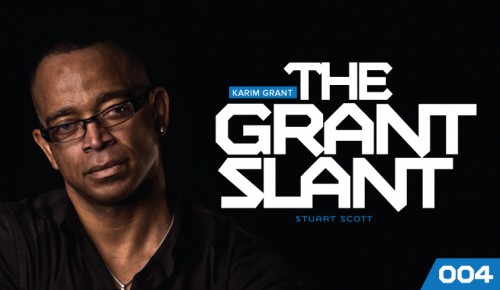I credit the incredible nasty Nas for helping me get through my early teenage sojourn into manhood. He spoke my language. He spat with vivid re-creation of his upbringing, surroundings and idyllic misgivings about life, love and loyalty. He framed his verses with brilliant imagery that depicted a struggle unbeknownst to most, however his essence transcended his vast housing project of Queens Bridge, New York and permeated young, impressionable teenage boys eight hours north of the border in the cold streets of suburban Toronto.
“Street’s disciple, I rock beats that’s mega trifle / And groovy, but smoother than moves by Villanova / You’re still a soldier, I’m like Sly Stone in Cobra / Packin’ like a rasta in the weed spot / Vocals’ll squeeze glocks, emcee’s eavesdrop / Though they need not to sneak / My poetry’s deep, I never fell / Nas’ raps should be locked in a cell / It ain’t hard to tell.” – Nas, “It Ain’t Hard To Tell”
Much like Nas was to ’90s hip-hop, Stuart Scott was to the new school of television sport journalism. He was the breath of fresh air the urban community so longed for with his poignant articulation, stark honesty and effervescent analogies and alliterations to hip-hop’s heroes, verses and urban rhetoric. His swagger personified a generation of hip-hoppers experiencing what some call the golden era of rap music (the early to mid-’90s). At a time when shows like “Yo! MTV Raps and “The Box” dominated video music channels, Scott found a way to mesh that music video format into the broadcasting of nightly highlights from popular professional sports, most importantly, the sports associated with urban America: football, basketball and to a lesser degree, baseball.
Scott’s ascension to notoriety and fame is credited to an apt ability to relate to his audience through modern day urban slang coupled with articulate and accurate references to his broad knowledge of sports, and their polarizing figures. He comfortably segued from sport to sport with the same uncanny familiarity as a DJ that would blend his music while playing for a jam-packed club. His style, although refreshing to some, was met with some criticism by others who felt as though his delivery was a little to over-the-top and far too “street” for the discerning viewing audience that ESPN had created a decade prior.
In Scott, aspiring journalists like Stephen A. Smith and J.A. Adande now had someone who paved the way for a new style of television journalism. It allowed them to remove the cloud of obscurity and objectivity, and replace it with a light of illustriousness and subjectivity.
But haters gonna hate. Nas’ first studio album was met with critical acclaim and quickly became an instant classic, garnering the coveted five mic distinction from The Source magazine. Despite its success, I distinctly remember a few heads back in the day that felt that Nas’ first LP Illmatic wasn’t all that it was proposed to be. Some felt it was too short, only 10 songs. Some felt it was too soft and that it was simply one man’s rendition of a life witnessed, but not yet experienced. Either way, Nas’ early success proved to be a cause for celebration, as a leader of a new school of thought had been born to the culture.
In Scott, aspiring journalists like Stephen A. Smith and J.A. Adande now had someone who paved the way for a new style of television journalism. It allowed them to remove the cloud of obscurity and objectivity, and replace it with a light of illustriousness and subjectivity. Moreover, to put it simply, a cipher had manifested itself on primetime television, and kids in the inner cities of America were dunking Nerf basketballs on the heads of their siblings while screaming, “Booyah!”
“Vlade Daddi, he likes to party, he don’t cause trouble, he don’t bother nobody.” – Originally from Slick Rick’s “Lodi Dodi”, later covered by Snoop Dogg on the Doggystyle album, and creatively quoted by Scott when reporting on Sacramento Kings center, Vlade Divac.
My friends and I experienced a sheltered life here in Canada. ESPN was a distant relative of TSN – which for a long time was our only all-sports television network. We were showered with multiple replays and highlights of mundane games of the country’s favourite national sport, hockey. Every game, every penalty, every fight, every goal were spoken of with such pride and reverence. The odd time we’d get a basketball highlight, it would come toward the end of the broadcast and would simply fill a small void of time, as if to appease the minute population of interested viewers.
For this reason, my jaunts to the U.S. were that much more momentous. Not only did ESPN have its main channel, the station somehow managed to convince the powers that be to afford it the opportunity to develop another channel, ESPN2. ESPN2 gave birth to the likes of Stuart Scott and a more laid back approach to broadcasting. Gone were the stuffy, double-breasted suits, donned by the likes of Chris Berman and Greg Gumbel and birthed were the bright-coloured sport jackets, open collared shirts and denim pants worn by Scott. A new era was born, whether the critics liked it or not.
Every time a reference is made to a famous rapper or hip-hop catch phrase during a sports cast, it is a reminder that this was made possible because of a young African American from North Carolina.
Stuart Scott eloquently used and sometime overused the term “cooler than the other side of the pillow,” to convey grace, excellence and prowess on the gridiron, hardwood and many other fields of play. Scott was in fact, the other side of pillow. A cool, breath of fresh air before bed as we watched Michael Jordan and Kobe Bryant soar to new heights in the NBA and were equally captivated by the feats of greatness possessed by the likes of Deion Sanders and Adrian Peterson on the football field.
For this, and many other reasons, my 260 lb frame was moved almost to tears when Scott said his speech at last year’s ESPY awards. His courage to fight the malignant disease, which had plagued him for over two years, was inspiring, however what ultimately got me choked up was the fact that the pioneer to urban broadcast journalism had seen his own denouement. The good die young. It’s true. The families and fans of Stack Bundles, Big L, The Notorious B.I.G., Tupac Shakur, Big Pun and, most recently, Grand Hustle artist Doe B, can attest to this fact. Many talented artists, athletes and celebrities have had their fate presented to them at an early age, leaving a legacy of promise and potential, while also leaving many to wonder what could have been had their life been prolonged.
Thankfully, Nasir Jones remains with us and an ever-growing catalogue of his artistry is ours to bear witness to. Regrettably, Scott’s catalogue has come to an end; nevertheless, his artistry remains with us to this day. Every time a reference is made to a famous rapper or hip-hop catch phrase during a sports cast, it is a reminder that this was made possible because of a young African American from North Carolina. An artist that decided to take the proverbial bull by the horns and produce a new way of delivering the daily sporting news through an unsullied, clairvoyant voice that spoke to newly-anointed Generation X’ers and their growing disdain for antiquated, old-fashioned, middle-aged and out-of-touch robot-like reporters.
When news of Scott’s death surfaced throughout various social media outlets, its ultimate truth reverberated throughout the sports industry like an ill-timed earthquake and shrouded sporting events like a dark cloud. It also brought to mind the fact that all talent, endowments and artistry must be applauded in not only their mortality, but should also be celebrated in their current existence while they’re still alive. Every now and then, an echo of “BOOYAH” should be heard, just because someone made it okay to do so.
@NorthernKingz




1 Comment
Pingback: Akil Augustine: A champion for urban media - Urbanology Magazine